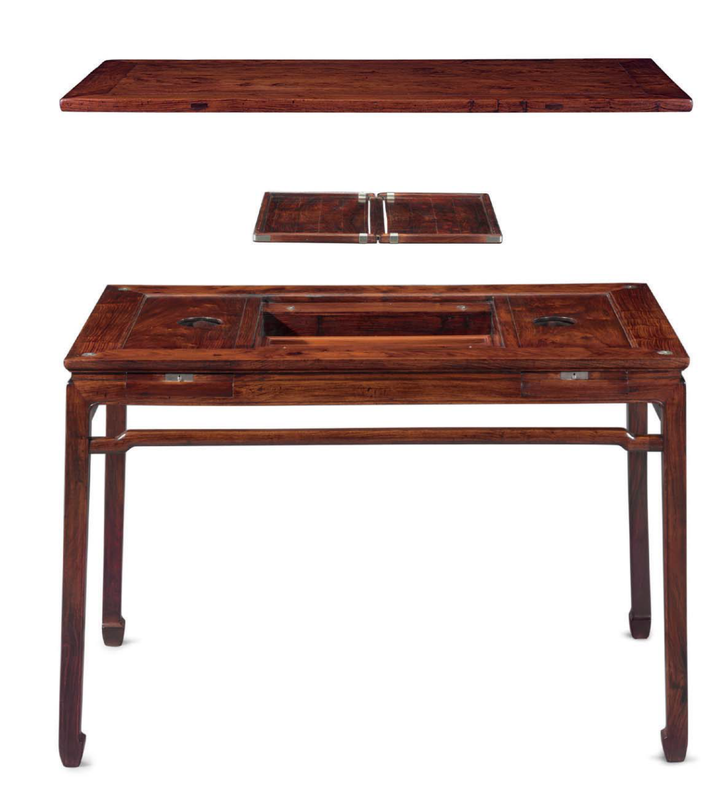A very rare huanghuali waisted rectangular corner-leg games table, China, Ming dynasty, 17th century
A very rare huanghuali waisted rectangular corner-leg games table, China, Ming dynasty, 17th century. Estimate $500,000 – $700,000. Photo Christie's Image Ltd 2015
The rectangular removable top conceals a rectangular recess for a shuanglu board, now lacking, and gaming boards and two cylindrical game piece cups, the whole supported on a narrow waist above a pair of drawers with baitongmounts and raised on beaded legs of square section joined by humpback stretchers and terminating in hoof feet; together with a folding xiangqi/weiqi board - 33 3/8 in. (84.8 cm.) high, 49 ½ in. (125.8 cm.) wide, 29 in. (73.8 cm.) deep
Provenance: Gift of Hei Hung Lu, Hong Kong, to Robert H. Ellsworth in honor of his 60th birthday, July 1989.
Notes: Games tables enjoyed particular popularity during the Ming dynasty (1368-1644). While designed to fulfill the specific requirements of various recreational activities, such tables were still required to serve in everyday use within a household, and could quickly transition between the two roles by simply replacing the top. Games tables are most often seen in square form, as square tables are more commonly associated with communal activities, such as dining and playing games. Rectangular games tables, such as the current example, are exceptionally rare. There do not appear to be any published images of rectangular games table with drawers, making this present table the only known example. For another huanghuali games table of rare rectangular form and dating to the 17th century, see the example in the Philadelphia Museum of Art illustrated by J. G. Lee, “Chinese Furniture Collection,” The Philadephia Museum of Art Bulletin, vol. LVIII:276 (Winter 1963), p. 70, fig. 14, which, like the current table, has removable game boards but features giant’s arms braces. See, also, the rectangular huanghuali games table in the Robert Winter Collection illustrated by G. Kates, Chinese Household Furniture, 1948, p. 80, pl. 33. For other examples of games tables, but of different form, see the example designed as a recessed-leg table with removable top in the Minneapolis Institute of Arts, illustrated by R.D. Jacobsen and N. Grindley, Classical Chinese Furniture, The Minneapolis Institute of Arts, Minneapolis, 1999, pp. 114-7, no. 37, and the square games table with cabriole legs and dragon spandrels illustrated by C. Evarts, A Leisurely Pursuit: Splendid Hardwood Antiquities from the Liang Yi Collection, Hong Kong, 2000, pp. 140-1, no. 45. Another square example in zitan, dated to the 17th century, is in the T.T. Tsui Museum of Art, Hong Kong, and illustrated by S. Handler, Austere Luminosity of Chinese Classical Furniture, Berkeley, 2001, p. 201.
For a detailed discussion of the popular board game weiqi, see C. Mackenzie and I. Finkel, eds., Asian Games: The Art of Contest, Asia Society, New York, 2004, pp. 186-201.
Christie's. THE COLLECTION OF ROBERT HATFIELD ELLSWORTH PART I - MASTERWORKS INCLUDING INDIAN, HIMALAYAN AND SOUTHEAST ASIAN WORKS OF ART, CHINESE AND JAPANESE WORKS OF ART, 17 March 2015, New York, Rockefeller Plaza

/https%3A%2F%2Fprofilepics.canalblog.com%2Fprofilepics%2F1%2F0%2F100183.jpg)
/https%3A%2F%2Fstorage.canalblog.com%2F03%2F02%2F119589%2F96711876_o.jpg)
/https%3A%2F%2Fstorage.canalblog.com%2F11%2F31%2F119589%2F94773502_o.jpg)
/https%3A%2F%2Fstorage.canalblog.com%2F20%2F83%2F119589%2F94772815_o.jpg)
/https%3A%2F%2Fstorage.canalblog.com%2F26%2F72%2F119589%2F75604929_o.jpg)
/https%3A%2F%2Fstorage.canalblog.com%2F59%2F60%2F119589%2F26458628_o.jpg)





/http%3A%2F%2Fstorage.canalblog.com%2F05%2F64%2F119589%2F128523518_o.jpg)
/http%3A%2F%2Fstorage.canalblog.com%2F78%2F46%2F119589%2F127133605_o.jpg)
/http%3A%2F%2Fstorage.canalblog.com%2F99%2F82%2F119589%2F126892955_o.jpg)
/http%3A%2F%2Fstorage.canalblog.com%2F51%2F84%2F119589%2F122518624_o.jpg)